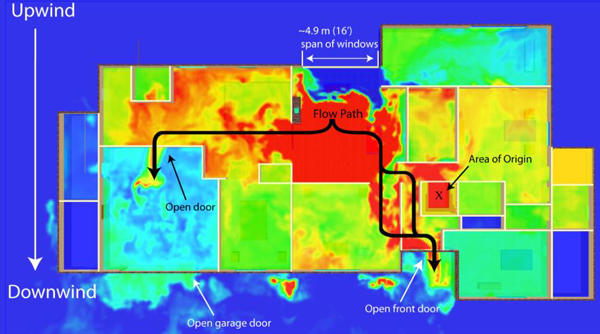Firefighter Fatality & Injury Studies
Wind-Driven Fire in a Ranch-Style House in Texas, 2009
On April 12, 2009, a fire in a one-story ranch home in Texas claimed the lives of two fire fighters. Sustained high winds occurred during the incident. The winds caused a rapid change in the dynamics of the fire after the failure of a large section of glass in the rear of the house.

Wind Driven Fire in Home, Texas, 2009. Aerial view of damage to the structure. Photo credit: Houston Fire Department.
NIST performed computer simulations of the fire using the Fire Dynamic Simulator (FDS) and Smokeview, a visualization tool, to provide insight on the fire development and thermal conditions that may have existed in the residence during the fire.
The FDS simulation that best represents the witnessed fire conditions indicates that the fire that spread throughout the attic and first floor developed a wind driven flow with temperatures in excess of 260 °C (500 °F) between the den and front door. The critical event in this fire was the creation of a wind-driven flow path between the upwind side of the structure and the exit point on the downwind side of the structure, the front door. The flow path was created by the failure of a large span of windows in the den, in the rear of the structure. Floor-to-ceiling temperatures rapidly increased in the flow path where multiple crews were performing interior operations. In a simulation that excluded wind, the flow path was not created, and the thermal environment surrounding the location of interior operations was improved.

Still image from FDS simulation. Temperatures at 1.5 m (5 ft) above the floor throughout the house 10 s after solarium failure. Image credit: NIST.
Wind has been recognized as a contributing factor to fire spread in wildland fires and large-area conflagrations and wildland fire fighters are trained to account for the wind in their tactics. While structural fire departments have recognized the impact of wind on fires, in general, the standard operating guidelines for structural fire fighting have not changed to address the hazards created by a wind driven fire inside a structure. The results of the "no-wind" and "wind" fire simulations demonstrate how wind conditions can rapidly change the thermal environment from tenable to untenable for fire fighters working in a single-story residential structure fire. The simulation results emphasize the importance of including wind conditions in the scene size-up before beginning and while performing fire fighting operations and adjusting tactics based on the wind conditions. These results are in agreement with NIST studies conducted to examine wind driven fire conditions in high-rise structures. (See 7-story building experiments below.)
LESSONS LEARNED
Based on the analysis of this fire incident and results from previous studies, adjusting fire fighting tactics to account for wind conditions in structural fire fighting is critical to enhancing the safety and the effectiveness of fire fighters. Previous studies demonstrated that applying water from the exterior, into the upwind side of the structure can have a significant impact on controlling the fire prior to beginning interior operations. It should be made clear that in a wind-driven fire, it is most important to use the wind to your advantage and attack the fire from the upwind side of the structure, especially if the upwind side is the burned side. Interior operations need to be aware of potentially rapidly changing conditions.
See full report, Simulation of the Dynamics of a Wind-Driven Fire in a Ranch-Style House – Texas (NIST TN 1729, January 2012)

